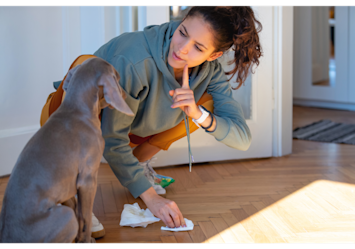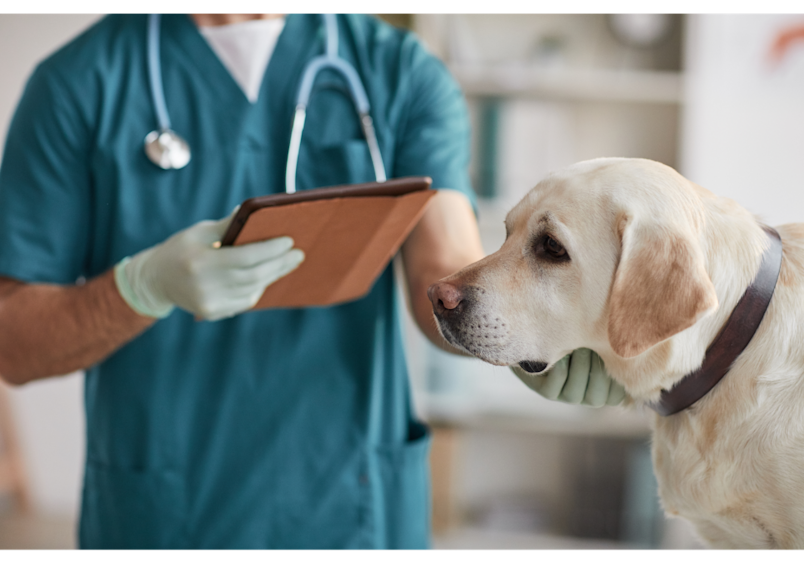
Every dog owner has been there. You walk in the front door, take a deep breath, and immediately get that unmistakable whiff of dog urine, even after you just spent an hour scrubbing the floor. That lingering smell isn't a sign that you didn't clean well enough; it's a result of the unique chemical makeup of urine that traditional cleaners can't fully break down.
Learning how to tackle carpet accidents and eliminate persistent odors is important for pet parents dealing with indoor mishaps. Even well-trained dogs occasionally have accidents, and without proper treatment, urine odors can persist and encourage repeat incidents in the same location. The key to success lies in completely neutralizing the smell-causing compounds—not just masking them—since dogs can detect residual scents that are unnoticeable to humans.
Why Does Dog Pee Smell So Bad?
Dog urine contains more than just water; it's a complex mix of ammonia, uric acid, pheromones, and bacteria. When left untreated, these compounds break down and release increasingly powerful odors—especially as bacteria feed on them over time.
What makes these accidents so difficult to eliminate:
Uric acid crystals bond tightly to carpet fibers and other porous materials
Ammonia creates that sharp, unmistakable "dog pee" odor that intensifies in warm conditions
Even if you can't smell it, your dog's superior sense of smell can still detect residual traces
If you don't fully neutralize the urine smell using proper enzymatic breakdown, your dog may keep returning to the same spot.
How to Find Dog Pee Stains in Your Home
Using your nose alone isn't always effective for locating all urine spots, particularly with dried stains or in multi-pet households where odors may overlap. Your best bet is a UV light flashlight—urine glows bright yellow green under black light, making it easy to spot even old, seemingly clean stains that have been masked by previous cleaning attempts.
If you don't have a UV light available, look for visual clues like discolored carpet areas, crusty or stiff spots in fabric, and white residue marks. Feel for areas that seem slightly damp or have a different texture than surrounding carpet. Follow your nose to the strongest odor points, which often indicate the center of contaminated areas.
For a thorough search with UV light, turn off all lights and scan your carpets, furniture, and baseboards systematically with the light held 6-12 inches from surfaces. Pay special attention to corners, areas near doors, and your dog's favorite spots.
Pro Tip: Work in a completely dark room and mark each spot you find with masking tape. Track these locations over a week to identify patterns—this information is invaluable for both thorough cleaning and helping your veterinarian diagnose potential underlying medical or behavioral issues

How to Get Rid of Dog Pee Smell from Every Surface in Your Home
Effective urine odor removal requires breaking down the odor-causing compounds at their source rather than simply covering them with fragrances. Here's how to properly clean dog pee from various surfaces:
How To Get Dog Pee Out of Carpet
Blot Up the Urine Immediately
Use thick paper towels to absorb as much liquid as possible
Press down firmly—never rub, as this pushes urine deeper
Rinse with Cool Water
Pour cool water directly onto the spot to dilute remaining urine
Blot again thoroughly
Apply an Enzyme Cleaner
Saturate the area with pet-specific enzymatic cleaner
Allow 10-15 minutes for proper breakdown
Final Blotting and Air Drying
Absorb remaining moisture with fresh towels
Block pet access until completely dry
Getting Dog Pee Smell Out of Other Surfaces
Upholstery/Couch:
Blot immediately, apply enzymatic cleaner sparingly
For persistent odors: sprinkle baking soda overnight, then vacuum
Hardwood Floors:
Act immediately—urine penetrates wood grain
Use wood-safe enzymatic cleaners only
Fabric Items:
Pre-treat with pet-safe cleaner
Wash in hottest safe water, air dry in sunlight when possible
How to Get Rid of Dog Pee Smell with DIY Cleaners
If you prefer homemade cleaners or need an immediate solution, these DIY recipes can effectively neutralize dog urine odors.
Homemade Cleaning Solutions:
Vinegar & Baking Soda Solution: Mix 1 cup white vinegar + 1 cup water + 2 teaspoons baking soda (test first—vinegar can damage natural fibers)
Hydrogen Peroxide Mix: Combine ½ cup hydrogen peroxide (3%) + 1 teaspoon dish soap + 1 tablespoon baking soda (warning: may bleach carpets and fabrics—always test first)
Critical Mistakes to Avoid When Cleaning Dog Pee
While the right cleaning methods are crucial, it's just as important to know what not to do. Using the wrong products or techniques can make the problem worse, setting the stain and odor permanently.
Using ammonia-based cleaners creates confusion for dogs since ammonia smells similar to urine and may encourage remarking.
Steam cleaning before proper treatment permanently sets protein-based stains through heat activation.
Surface-only cleaning fails because liquid penetrates deep into carpet padding and subflooring.
Scented products that merely mask odors are ineffective since dogs can still detect the underlying smell through artificial fragrances.
Understanding Why Dogs Pee Indoors and When to Seek Help
Identifying what's causing your dog's accidents helps address the root problem alongside cleanup efforts. Here are the most common reasons and when professional intervention is necessary:
Cause | Signs to Watch For | When to See a Vet |
UTI or Medical Issues | Frequent urination, straining, blood in urine | ASAP - Don't delay! |
Anxiety or Stress | Accidents during storms, schedule changes | If persistent |
Territorial Marking | Small amounts on vertical surfaces | If sudden or excessive |
Incomplete Housebreaking | Large puddles, young dogs | If no progress after 2-3 weeks |
Submissive/Excitement Urination | Accidents during greetings, play | If interfering with daily life |
Pet Insurance for Dog Pee Accidents and Underlying Health Issues
If your house-trained dog suddenly starts having accidents, especially with blood in urine or signs of pain, contact your veterinarian immediately. Having a financial safety net for unexpected veterinary visits provides invaluable peace of mind for pet parents during these situations.
When dealing with recurring accidents or underlying medical conditions, dog insurance can be particularly helpful. It allows you to focus entirely on your dog's health rather than worrying about treatment costs, especially important for chronic conditions like recurring UTIs or behavioral issues that may require ongoing veterinary management.
A single, uncomplicated urinary tract infection (UTI) can cost between $100 and $200 to diagnose and treat, but that price can increase significantly if the infection is chronic or leads to more serious issues. Similarly, treating behavioral issues like anxiety can require multiple vet visits and medication, with costs ranging from simple calming supplements to hundreds of dollars for prescription medication and professional behavioral therapy. Pet insurance allows you to focus entirely on your dog's health rather than worrying about treatment costs for chronic conditions.
Consider adding a wellness plan to your insurance to help you budget for routine preventive care that can help identify urinary issues early, before they become serious problems.

Successfully Getting Rid of Dog Pee Smell for Good!
Once you know your pup is healthy, you can focus on the smell. The most effective long-term strategy for eliminating the scent of dog urine combines proper cleanup techniques with accident prevention. Focus on providing frequent potty breaks and maintaining consistent routines to reduce the likelihood of indoor accidents. Block access to previously soiled areas while they're being treated, address any underlying medical issues promptly, and use positive reinforcement training to encourage appropriate elimination behaviors.
Successfully removing dog urine odor requires patience, proper enzymatic cleaners, and addressing both visible stains and invisible odor molecules. Always use enzyme-based cleaners designed specifically for pet urine, treat the entire affected area thoroughly, and be prepared for multiple treatments on severe odors.
Don't be discouraged by past attempts that failed; the key is to address both the mess you see and the smell your dog can still detect. With these proven methods, you can once again walk into your home and breathe a sigh of relief, confident that it smells fresh and welcoming.